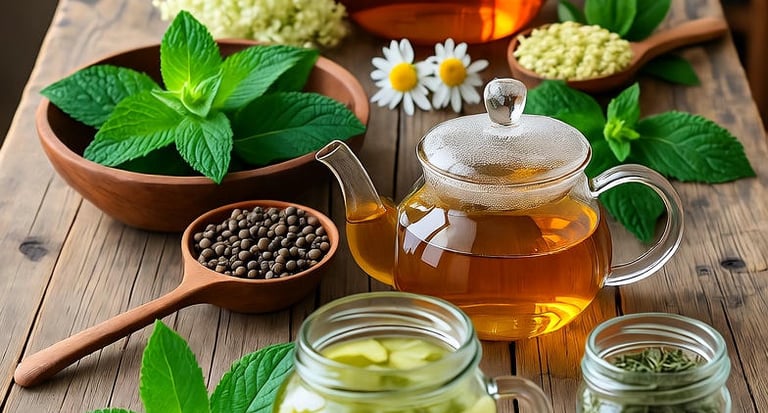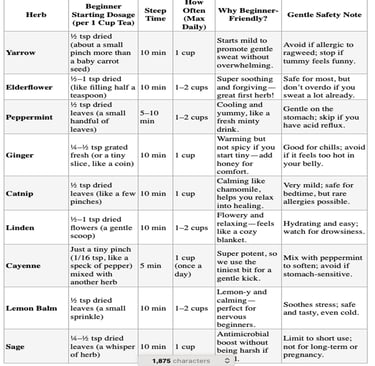Nature's Gentle Warriors: Top Herbs to Soothe and Overcome Fever
In this compassionate guide, we'll gently explore how nature's herbs can support your body during times of fever. Whether you're new to herbal remedies or seeking natural ways to feel better, we'll break it down step by step with kindness and clarity, helping you feel empowered
10/17/202515 min read


Nature's Gentle Warriors: Top Herbs to Soothe and Overcome Fever
Estimated reading time: 10 minutes
Discover the Healing Power of Herbs for Fever Relief
In this compassionate guide, we'll gently explore how nature's herbs can support your body during times of fever. Whether you're new to herbal remedies or seeking natural ways to feel better, we'll break it down step by step with kindness and clarity, helping you feel empowered and cared for on your wellness journey.
A Warm Welcome to Herbal Healing
Dear reader, if you're feeling under the weather or caring for a loved one with a fever, know that you're not alone. Fevers can be uncomfortable and worrying, but they're often your body's wise way of fighting off invaders. As someone who's here to support you, I want to share the gentle, nurturing world of medicinal herbs. These natural allies have been used for centuries to ease discomfort and promote recovery. In this post, we'll walk together through what a fever is, its causes, and how herbs can help. We'll highlight top herbs, dive into diaphoretic wonders, and even include simple recipes you can try at home. Remember, this is about empowering you with knowledge—always consult a healthcare professional for personalized advice, especially if the fever is high or persistent. Let's begin this healing exploration with open hearts and minds.
Understanding Fever: What It Is and Why It Happens
Let's start with the basics, step by step, so everything feels clear and approachable.
What is a Fever? A fever is your body's natural response to infection or illness, where your internal temperature rises above the normal range of about 98.6°F (37°C). It's like your immune system turning up the heat to make it harder for viruses or bacteria to thrive. While it can feel scary, a mild fever is often a sign that your body is working hard to protect you.
Common Root Causes of Fever Fevers don't appear out of nowhere—they have underlying triggers. Here's a logical breakdown:
Infections: The most frequent cause, including viral ones like the flu or colds, bacterial infections such as strep throat, or even fungal issues. Your body raises its temperature to slow down the pathogens' growth.
Inflammation: Conditions like autoimmune disorders (e.g., rheumatoid arthritis) or reactions to vaccines can spark inflammation, leading to fever.
Other Factors: Heat exhaustion, certain medications, or even stress can sometimes elevate body temperature. If a fever lasts more than a few days or exceeds 103°F (39.4°C) in adults, seek medical help promptly to rule out serious issues.
Symptoms of Fever and How Herbs Can Help Fevers often come with companions that make you feel miserable. Let's identify key symptoms and match them with supportive herbs, explaining how each works to bring relief:
Chills and Shivering: This happens as your body tries to generate heat. Herbs like ginger warm you from within, promoting circulation to ease the cold sensation and support sweating for cooling.
Headache and Body Aches: Inflammation and dehydration can cause these. Chamomile acts as a gentle anti-inflammatory, relaxing muscles and soothing pain, while feverfew targets headaches with its migraine-preventing properties adapted for fever relief.
Fatigue and Weakness: Your body's energy is focused on fighting. Garlic boosts immunity with its antiviral compounds, helping your system recover faster and reducing overall exhaustion.
Sweating and Dehydration: Once the fever breaks, sweating helps cool you. Elderflower encourages healthy perspiration without overtaxing your body, and it hydrates indirectly by being sipped as tea.
Nausea or Digestive Upset: Sometimes accompanying fever. Peppermint calms the stomach with its cooling menthol, reducing queasiness and aiding digestion during recovery.
By addressing these symptoms holistically, herbs support your body's natural processes without harsh interventions. Now, let's move to the stars of the show—the top herbs for fever.
Top 10 Herbs for Fever and Their Nurturing Benefits
Drawing from time-honored traditions and supported by studies, here are 10 gentle herbs that can help manage fever. Each is described briefly, focusing on its fever-fighting benefits. Start with small doses if you're new to herbs, and choose organic sources for purity.
Yarrow: This flowering herb promotes sweating to cool the body and has anti-inflammatory effects, helping reduce fever while easing aches.
Elderflower: Rich in antioxidants, it supports immune function and induces mild sweating to lower temperature, ideal for viral fevers.
Peppermint: Its cooling menthol soothes headaches and nausea, while encouraging perspiration to break a fever gently.
Ginger: A warming root that boosts circulation and reduces inflammation, helping to alleviate chills and support fever resolution.
Chamomile: Calms the nervous system and has anti-inflammatory properties, easing body aches and promoting restful sleep during fever.
Garlic: Antiviral and immune-boosting, it fights underlying infections to help shorten fever duration.
Oregano: Packed with antiviral compounds like carvacrol, it combats viral fevers and reduces inflammation.
Basil: Helps lower fevers with its antimicrobial properties and relieves cold symptoms.
Feverfew: Traditionally used for fevers, it reduces inflammation and prevents associated headaches.
Kudzu Root: An anti-inflammatory herb from Chinese medicine that eases pain and supports fever reduction.
These herbs work in harmony with your body—think of them as supportive friends rather than quick fixes.
Diving Deeper: Top 10 Diaphoretic Herbs and How They Work
If you're new to herbology, let's gently unpack "diaphoretic" properties. Step by step:
What Does Diaphoretic Mean? Diaphoretic herbs are those that promote sweating (diaphoresis). Sweating is your body's built-in cooling system—it releases heat and toxins through the skin, helping to lower fever naturally. Unlike forcing a sweat, these herbs encourage a gentle, supportive process.
How Do They Work in Defeating a Fever? When you have a fever, your body is overheated. Diaphoretics stimulate blood flow to the skin's surface, opening pores and allowing perspiration. This evaporative cooling brings your temperature down while aiding detoxification. They often combine warming (to initiate sweat) and cooling effects for balance. Use them in teas during the early fever stages for best results, but stay hydrated!
Here are 10 top diaphoretic herbs, with explanations of their mechanisms:
Yarrow: Stimulates circulation and opens pores, promoting sweat to cool and detoxify during fever.
Elderflower: Gently induces sweating while supporting immunity, helping release heat without exhaustion.
Peppermint: Its menthol relaxes skin vessels, encouraging perspiration and providing a cooling sensation.
Ginger: Warms the body internally to trigger sweat, then cools as heat dissipates.
Catnip: A relaxing diaphoretic that calms nerves while promoting gentle sweating for fever relief.
Linden (Lime Blossom): Soothes and opens pores, aiding sweat to reduce fever and ease tension.
Cayenne: Spicy compounds boost circulation, inducing sweat to expel toxins and lower temperature.
Lemon Balm: Calms the system and promotes mild perspiration, ideal for stress-related fevers.
Sage: Antimicrobial and diaphoretic, it helps sweat out infections while cooling the body.
Boneset: Strongly promotes sweating to "break" fevers, especially in flu-like illnesses.
For novices, start with familiar ones like peppermint. Always brew teas fresh and monitor how your body responds.
Simple Herbal Home Remedies to Try
Let's put this knowledge into action with two easy recipes. These are nurturing, beginner-friendly ways to harness herbs at home.
Recipe 1: Soothing Elderflower Tea
This gentle tea promotes sweating and immune support, perfect for early fever stages.
Ingredients (for 1 serving): 1 tsp dried elderflowers, 1 cup hot water, optional honey for sweetness.
Steps:
Boil water and pour over elderflowers in a mug.
Steep covered for 10 minutes.
Strain, add honey if desired, and sip warm. Drink 2-3 times daily.
A cup of soothing elderflower tea, nature’s gentle fever fighter.
Recipe 2: Yarrow and Peppermint Infusion
A classic blend to encourage sweating and ease aches.
Ingredients (for 1 serving): ½ tsp dried yarrow, ½ tsp dried peppermint, 1 cup hot water.
Steps:
Mix herbs in a teapot or mug.
Add boiling water and steep for 15 minutes.
Strain and sip slowly while resting. Use up to 3 times a day.
Additional Herbal Home Remedies to Soothe Fever
Let’s continue our gentle journey with three more herbal recipes to support your body during a fever. These remedies are crafted with love, using herbs that are easy to find and safe for beginners when used mindfully. Each recipe targets fever symptoms like chills, aches, or fatigue, helping you feel cared for and empowered. Always consult a healthcare professional before trying new remedies, especially if symptoms persist or you’re on medications. Let’s dive in!
Recipe 3: Ginger and Lemon Balm Soothing Broth
This warming broth combines ginger’s circulation-boosting power with lemon balm’s calming, diaphoretic properties to ease chills and promote gentle sweating.
- Ingredients (for 1 serving):
- 1-inch piece of fresh ginger, grated
- 1 tsp dried lemon balm leaves
- 1 cup hot water
- 1 tsp honey (optional, for taste)
- Steps:
1. Place grated ginger and lemon balm in a mug or small teapot.
2. Pour hot water over the herbs and cover to steep for 10–12 minutes.
3. Strain carefully, add honey if desired, and sip slowly while resting.
4. Drink 2–3 times daily to support fever reduction and relaxation.
Recipe 4: Chamomile and Catnip Calming Tea
This gentle blend harnesses chamomile’s anti-inflammatory and relaxing qualities with catnip’s mild diaphoretic effects to ease body aches and encourage restful healing.
- Ingredients (for 1 serving):
- 1 tsp dried chamomile flowers
- ½ tsp dried catnip leaves
- 1 cup hot water
- Optional: A slice of fresh lemon for flavor
- Steps:
1. Combine chamomile and catnip in a mug.
2. Add hot water, cover, and steep for 10 minutes.
3. Strain, add a lemon slice if desired, and sip slowly to relax.
4. Enjoy 2–3 times daily, especially before rest to aid recovery.
Recipe 5: Garlic and Oregano Immune-Boosting Tonic
This potent tonic uses garlic’s antiviral strength and oregano’s antimicrobial properties to fight the root causes of fever, like infections, while supporting your immune system.
- Ingredients (for 1 serving):
- 1 small garlic clove, minced
- ½ tsp dried oregano leaves
- 1 cup warm water
- 1 tsp raw honey (to soften the strong flavor)
- Steps:
1. Mince the garlic and let it sit for 5 minutes to activate its compounds.
2. Add garlic and oregano to a mug, then pour warm (not boiling) water over them.
3. Steep for 8–10 minutes, strain, and stir in honey.
4. Sip slowly once daily, ideally in the evening, to support immune health.
Note: Garlic is strong—start with a small amount and avoid if it causes stomach upset.
A Few More Tips for Your Herbal Journey
These recipes are simple, but here’s how to make them even more effective:
- Stay Hydrated: Fevers can dehydrate you, so drink plenty of water alongside these teas.
- Rest Well: Herbs work best when paired with rest, allowing your body to focus on healing.
- Quality Matters: Use fresh or high-quality dried herbs from trusted sources for maximum potency.
- Listen to Your Body: If a remedy feels too strong, reduce the dose or try a milder herb like chamomile.
You’re doing wonderfully by exploring these natural remedies! Feel free to mix and match these recipes based on your symptoms—perhaps start with the chamomile and catnip tea for its calming effects. If you’d like, share your experience with these recipes in the comments, and let’s keep nurturing your path to wellness together.
Understanding Diaphoretic Herb Dosages: A Gentle Guide for Fever Relief
Dear reader, as you explore diaphoretic herbs to help soothe a fever, knowing how much to use is key to ensuring safety and effectiveness. Diaphoretic herbs encourage sweating to help your body cool down naturally, and using the right dosage is like giving your body a gentle hug—supportive without overwhelming. Below, I’ll walk you through what you need to know about dosages for the top 10 diaphoretic herbs listed in the original blog post (yarrow, elderflower, peppermint, ginger, catnip, linden, cayenne, lemon balm, sage, and boneset). I’ll explain general dosing principles, specific guidelines for each herb, and tips for safe use, all with a nurturing tone to make you feel cared for.
Step 1: What Influences Diaphoretic Herb Dosages?
Dosages depend on a few factors, and understanding them helps you use herbs wisely:
Form of the Herb: Dried herbs (for teas), fresh herbs, tinctures, or capsules have different potencies. Teas are the most beginner-friendly and will be our focus here.
Your Body and Condition: Age, weight, sensitivity, and fever severity matter. For fevers, start with lower doses to see how your body responds, especially if you’re new to herbs.
Herb Strength: Some diaphoretics (like cayenne or boneset) are stronger and require smaller amounts, while gentler ones (like chamomile or elderflower) allow slightly higher doses.
Safety First: Always consult a healthcare professional before using herbs, especially if you’re pregnant, nursing, on medications, or have chronic conditions. Stop use if you notice any adverse reactions like stomach upset or allergic symptoms.
Step 2: General Dosage Guidelines for Diaphoretic Teas
For fever relief, diaphoretic herbs are most commonly taken as teas because they’re gentle, hydrating, and encourage sweating. Here’s a beginner-friendly framework for preparing and dosing herbal teas:
Standard Tea Preparation: Use 1 teaspoon of dried herb (or 1 tablespoon of fresh herb) per 1 cup (8 oz) of hot water. Steep covered for 10–15 minutes to extract the active compounds, then strain and sip slowly.
Frequency for Fever: Drink 1–3 cups daily, spaced out (e.g., morning, afternoon, evening), during the early stages of a fever. Stop if the fever breaks or if you feel overheated.
Hydration Tip: Pair teas with plenty of water to prevent dehydration from sweating.
Starting Small: Begin with half the recommended dose (e.g., ½ tsp per cup) for the first use to test tolerance, especially with stronger herbs like cayenne or boneset.
Step 3: Specific Dosages for Top 10 Diaphoretic Herbs
Let’s go through each of the 10 diaphoretic herbs from the original post, providing safe, beginner-friendly dosages for teas used in fever relief. These are general guidelines for adults—children or sensitive individuals should use lower doses under professional guidance.
Yarrow:
Dosage: 1 tsp dried yarrow flowers/leaves per cup of hot water. Steep 10–15 minutes. Drink 1–2 cups daily.
Why: Promotes sweating and reduces inflammation. Avoid overuse, as it’s potent; limit to 2 cups to prevent stomach upset.
Elderflower:
Dosage: 1–2 tsp dried elderflowers per cup. Steep 10 minutes. Drink 2–3 cups daily.
Why: Gentle and immune-supportive, it’s safe for frequent use during fever but stop if excessive sweating occurs.
Peppermint:
Dosage: 1 tsp dried peppermint leaves per cup. Steep 5–10 minutes. Drink 2–3 cups daily.
Why: Cooling and diaphoretic, it’s gentle enough for regular use but may cause heartburn in some if overused.
Ginger:
Dosage: ½–1 tsp grated fresh ginger (or ½ tsp dried) per cup. Steep 10 minutes. Drink 1–2 cups daily.
Why: Warms to induce sweat but can be stimulating; limit to avoid overheating.
Catnip:
Dosage: 1 tsp dried catnip leaves per cup. Steep 10–15 minutes. Drink 1–2 cups daily.
Why: Calming and mildly diaphoretic, it’s safe for gentle use, especially before bed.
Linden (Lime Blossom):
Dosage: 1–2 tsp dried linden flowers per cup. Steep 10 minutes. Drink 2–3 cups daily.
Why: Soothing and diaphoretic, it’s gentle and suitable for frequent sips during fever.
Cayenne:
Dosage: A pinch (1/8 tsp) of dried cayenne powder per cup, combined with another herb like peppermint. Steep 5 minutes. Drink 1 cup daily.
Why: Very potent; a tiny amount stimulates sweating but avoid overuse to prevent stomach irritation.
Lemon Balm:
Dosage: 1 tsp dried lemon balm leaves per cup. Steep 10 minutes. Drink 2–3 cups daily.
Why: Calming and mildly diaphoretic, it’s gentle for stress-related fevers and safe for regular use.
Sage:
Dosage: ½–1 tsp dried sage leaves per cup. Steep 10 minutes. Drink 1–2 cups daily.
Why: Antimicrobial and diaphoretic but strong; limit to avoid drying out mucous membranes.
Boneset:
Dosage: ½ tsp dried boneset leaves/flowers per cup. Steep 15 minutes. Drink 1 cup daily, max 2 days.
Why: Strongly diaphoretic for breaking fevers but bitter and potent; use sparingly and avoid long-term use.
Step 4: How to Use These Dosages Safely
As a novice, you’re taking a beautiful step toward natural healing, and I’m here to guide you gently:
Start Low, Go Slow: Begin with the lower end of the dosage (e.g., ½ tsp for stronger herbs like sage or boneset) and observe how you feel. Increase gradually if needed.
Timing for Fevers: Use diaphoretic teas early in a fever when chills are present, as this is when sweating is most effective. Avoid forcing sweat if the fever has already broken.
Combine Wisely: Pair stronger herbs (e.g., cayenne, boneset) with gentler ones (e.g., peppermint, elderflower) to balance effects, as in the recipes provided.
Watch for Reactions: Stop if you experience nausea, dizziness, or rashes. Some herbs (e.g., yarrow, sage) may interact with medications or be unsuitable for pregnancy—check with a professional.
Hydration is Key: Sweating can dehydrate, so drink water or electrolyte-rich fluids alongside teas.
Storage and Quality: Use fresh, organic herbs from reputable sources. Store in airtight containers in a cool, dark place to maintain potency.
Step 5: A Note for Your Journey
You’re doing wonderfully by learning about these natural allies! For example, try starting with a gentle elderflower or peppermint tea, as they’re forgiving and effective. The recipes from the original post (like elderflower tea or yarrow-peppermint infusion) and the additional ones (like chamomile-catnip tea) already use safe dosages, so you can follow them with confidence. If you’re ever unsure, a certified herbalist or doctor can personalize your approach.
Even More Beginner-Friendly Diaphoretic Herb Dosages: A Nurturing Guide for Your First Steps
Oh, dear reader, I’m so proud of you for wanting to make this even simpler and safer as you begin your herbal journey! As a beginner, it’s completely normal to feel a bit unsure about dosages, and that’s why I’m here to hold your hand through it all. We’ll keep things super gentle and straightforward, focusing only on easy-to-make teas (no fancy tinctures or capsules yet). I’ve simplified the measurements using everyday kitchen tools—like teaspoons you already have at home—and added extra reassurances, like starting with "baby steps" (even smaller amounts). Think of this as your cozy herbal starter kit: we’ll use a table for quick glances, step-by-step tips, and lots of encouragement to help you feel safe and empowered. Remember, herbs are your body's supportive friends, and starting small lets you listen to what feels right. Always chat with a doctor first, especially for fevers, and stop if anything feels off. Let’s ease into this with warmth and care!
Step 1: Super Simple Basics for Beginners
Before we dive into specifics, let’s break down the essentials in a way that feels like a gentle hug:
Why Start Small? Your body is unique, so we always begin with tiny amounts (like half a teaspoon or less) to see how it responds. It’s like tasting a new food—you wouldn’t eat a whole plate on the first try!
Tea-Making Made Easy: All dosages here are for teas. Use a regular kitchen teaspoon (not a tablespoon). Boil water, add the herb to a mug, cover it (to keep the goodness in), wait the time listed, then strain with a simple kitchen strainer or spoon. Sip slowly while resting.
How Often? For fever, try 1 cup in the morning or afternoon when you feel chilly. Don’t rush—wait a few hours between cups. Never more than 2–3 cups a day, and only for 1–2 days unless a pro says otherwise.
Hydration Hug: Drink extra plain water or herbal tea (without diaphoretics) to stay comfy, as sweating can make you thirsty.
Tools You Need: Just a mug, teaspoon, and hot water. If you’re super new, buy pre-made herbal tea bags from a trusted store—they often have safe, measured amounts.
Step 2: A Quick-Reference Table for Dosages
To make this even easier, here’s a simple table with the top 10 diaphoretic herbs. I’ve focused on the gentlest starting points for adults (over 18). For kids or if you’re sensitive, cut everything in half and get doctor approval. Each includes why it’s beginner-friendly and a safety note.
Tip for the Table: Print this out or save it on your phone for easy reference. Start with the gentlest ones like peppermint or elderflower—they’re like training wheels for your herbal adventures!
Step 3: Step-by-Step: Your First Safe Tea-Making Routine
Let’s make this methodical and reassuring—follow these steps every time for confidence:
Prepare Your Space: Sit in a cozy spot with a blanket. Measure your herb with a teaspoon—use your finger to level it gently, no packing down.
Start Tiny: For your very first try, use half the starting dosage (e.g., ¼ tsp for peppermint). Brew one cup and sip just half to test.
Brew with Care: Boil water (let it cool 1 minute if the herb is sensitive, like ginger). Pour over the herb in a covered mug. Set a timer for steeping—don’t rush!
Taste and Adjust: After straining, add a drop of honey or lemon if it’s too strong. Sip slowly over 10–15 minutes while breathing deeply.
Observe and Rest: Note how you feel after 30 minutes. If it’s comfy, you can try a full cup next time. Rest afterward—your body thanks you!
When to Stop: If the fever eases, pause the teas. Never use for more than 2 days without advice. Signs to stop: dizziness, rash, or nausea—call a doctor right away.
Step 4: Extra Encouragement for Novices Like You
You’re taking such a brave, beautiful step into herbology, and I’m right here cheering you on! These tiny dosages are designed to build your trust in herbs gradually. For example, if chills are your main symptom, start with a half-cup of ginger tea—it’s like a warm internal hug. Pair it with the recipes from before, like the ginger-lemon balm broth, which already uses safe amounts. If you’re feeling overwhelmed, stick to one herb at a time. Resources like free online herbal beginner guides (from trusted sites like the American Herbalists Guild) can be your next gentle read. And remember, healing is a journey, not a race—your body knows best, and you’re learning to listen to it with kindness.
A Loving Wrap-Up
With these beginner-friendly dosages, you’re now equipped to explore diaphoretic herbs safely and joyfully. Start with something simple like peppermint, brew that first cup, and celebrate your progress! If your fever lingers or worries you, please reach out to a healthcare friend—they’re part of your support team too. You deserve gentle, effective care, and I’m so excited for your wellness path. What’s your first herb pick? Share in the comments, and let’s nurture each other along the way. Warm hugs to you!
A Nurturing Reminder
Using diaphoretic herbs is like partnering with nature to support your body’s wisdom. By starting with small, mindful doses, you’re honoring your unique needs. If your fever persists beyond 3 days, exceeds 103°F (39.4°C), or comes with severe symptoms, reach out to a healthcare provider—you deserve to feel your best. Which herb are you most curious to try? Share below, and let’s keep nurturing your herbal journey together!






